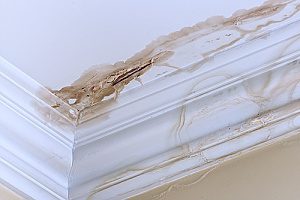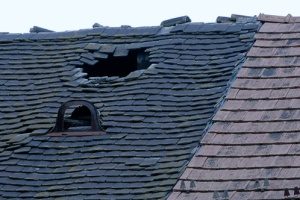 Roof leaks are one of the most frustrating maintenance tasks homeowners must deal with. Failure to fix a leaky roof can lead to extensive water damage, mold growth, wood rot, and similar issues. The longer you allow the problem to continue, the more costly it will be to repair. Depending on the circumstances, you may not be responsible for the cost of repair. Many times, your insurance company will step in to cover the expense if it meets certain criteria found in your policy. Learn what type of roof repair is usually covered by a general homeowner’s insurance policy and whether it is best to use your policy or pay out-of-pocket for repair costs.
Roof leaks are one of the most frustrating maintenance tasks homeowners must deal with. Failure to fix a leaky roof can lead to extensive water damage, mold growth, wood rot, and similar issues. The longer you allow the problem to continue, the more costly it will be to repair. Depending on the circumstances, you may not be responsible for the cost of repair. Many times, your insurance company will step in to cover the expense if it meets certain criteria found in your policy. Learn what type of roof repair is usually covered by a general homeowner’s insurance policy and whether it is best to use your policy or pay out-of-pocket for repair costs.
Homeowners Insurance and Leaky Roofs
From rotted framing to worn out shingles, there are many different reasons for a leaky roof. Whether or not the damage is covered by homeowners insurance will depend on a variety of factors. Most roof leaks are fully covered by insurance, meaning that you will be reimbursed for any roof repairs made. However, this is not always the case. It is important that you carefully read through your homeowner’s insurance policy to see which perils are covered and excluded. Perils covered under most policies include:
- Fire and smoke (including wildfires)
- Lightning
- Vandalism
- Explosions
- Theft
- Windstorms and hail
- Damage from vehicles or aircrafts
- Volcanic eruption
- Damage from riots
- Excess weight from ice, sleet, or snow
- Falling objects
- Sudden breaking of pipes or other household systems
- Freezing of AC, heating system, or other household amenities
- Sudden damage from an electrical surge
- Damage from the sudden discharge of steam or water
 In short, your homeowner’s insurance policy may cover the cost of roof damage that occurs sudden or accidentally. Malicious mischief and vandalism is also a covered peril, as the homeowner is not considered at fault for any damage. When considering whether or not your roof damage may be covered, consider how the damage occurred. Neglect is not sudden and a roof that leaks due to normal wear and tear is not sudden. Although settling may be sudden, it is usually an exclusion that is not covered by most homeowners’ insurance policies. Wet rot is also a common exclusion as it usually is not sudden and occurs over time.
In short, your homeowner’s insurance policy may cover the cost of roof damage that occurs sudden or accidentally. Malicious mischief and vandalism is also a covered peril, as the homeowner is not considered at fault for any damage. When considering whether or not your roof damage may be covered, consider how the damage occurred. Neglect is not sudden and a roof that leaks due to normal wear and tear is not sudden. Although settling may be sudden, it is usually an exclusion that is not covered by most homeowners’ insurance policies. Wet rot is also a common exclusion as it usually is not sudden and occurs over time.
What Homeowners Insurance Does Not Cover
In the U.S., the average cost of a roof replacement is just over $7,000. In the event of a major storm or other catastrophe, the thought of having to make major repairs or a full roof replacement can be overwhelming. Unfortunately, there are certain times when your roof repair claim may be denied. One of the most common reasons for a roof repair denial from your insurance company is due to your roof being too old. A roof may be considered too old if it is 20 years or older. In some cases, the insurance company will pay for the actual cash value of the roof, taking depreciation into account.
Your roof damage claim may also be denied if the damage was found to be your fault. Homeowners insurance will usually only cover damage that was done due to reasons beyond your control. If you are found at fault for the damage, it will not be reimbursed. For example, say a few roof shingles came loose and blew off your roof, exposing the underlayment to water. If you failed to fix the issue, insurance will likely not cover it.
Certain perils are not covered by standard homeowners insurance. Some of the most common perils not covered include flooding, pest infestation, earth movement like landslides and earthquakes, sewer backup, mold and mildew, nuclear leak or explosion, or a war or government-based action. If you desire coverage for a certain type of damage that is not covered under your standard policy, ask your insurance company about purchasing an additional policy. Remember that once you sign off on an insurance policy, you have essentially accepted the terms including the covered perils. If you have a problem with the policy, address the issue before signing the policy.
Deductibles and Roof Leak Coverage
 It is not always in the best interest of the homeowner to file a roof repair claim with their insurance company. Before making a decision to file, consider various aspects of your case, including your deductible. Many homeowner insurance policies have up to three different deductibles designed for various situations. If you have a standard deductible it may apply to all perils. However, most policies have a wind and hail deductible that is higher than the standard deductible. If you live near a coastline you may have another deductible that applies to damage caused by tropical storms.
It is not always in the best interest of the homeowner to file a roof repair claim with their insurance company. Before making a decision to file, consider various aspects of your case, including your deductible. Many homeowner insurance policies have up to three different deductibles designed for various situations. If you have a standard deductible it may apply to all perils. However, most policies have a wind and hail deductible that is higher than the standard deductible. If you live near a coastline you may have another deductible that applies to damage caused by tropical storms.
As a homeowner, you have the option to file a roof repair claim anytime you would like. However, there may be some consequences that come with filing a claim. If you file a claim unnecessarily or file multiple claims, you could find that your premiums are raised, your policy is cancelled, or you have difficulty finding coverage from another company. You may want to avoid filing a claim and pay out-of-pocket if the repairs are less than your deductible, if the roof damages are relatively minor, if the claim was caused by poor maintenance, or if you have filed more than one claim in the past decade.
Contact Roof Repair Contractors
Roofs can leak for a wide range of reasons, such as natural wear and tear, storm damage, or an animal infestation. While you cannot always prevent damage from occurring to your roof, you can ensure that the problem is fixed before it has the chance to get worse. Whether you decide to file a claim or not file a claim with your insurance company, it is important to hire professional roof repair contractors to inspect the roof and determine the extent of the damage. For more information about roof leaks or to schedule a roof repair estimate, contact the Northern Virginia roof repair contractors at Beyond Exteriors.